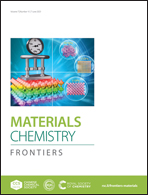Low-cost and LiTFSI-free diphenylamine-substituted hole transporting materials for highly efficient perovskite solar cells and modules†
Abstract
To date, the most efficient metal halide perovskite solar cells employ an n–i–p architecture that uses a 2,2,7′,7′-tetrakis(N,N-di-p-methoxyphenylamine)-9,9′-spirobifluorene (spiro-OMeTAD) as the hole-transporting material (HTM), which achieves optimum conductivity with the addition of lithium bis(trifluoromethane)sulfonimide (LiTFSI) and air exposure. However, the instability caused by these additives limits the further development of PSCs toward commercialization. Here, we designed and synthesized a novel HTM, 9-(4-((2-ethylhexyl)oxy)phenyl)-N2,N2,N7,N7-tetrakis(4-methoxyphenyl)-9H-carbazole-2,7-diamine (SC-2), and oxidized SC-2 was synthesized to dope SC-2 to replace the conventionally used spiro-OMeTAD system. The film conductivity, morphology, and solar cells were optimized by varying the doping content. As a result, a champion efficiency of 21.3% under AM 1.5G 1- sun irradiation is achieved, which is one of the best efficiencies of the HTL doped by its pre-oxidized salt. The non-encapsulated cells based on doped SC-2 retained 95% of their initial performance after aging for 1450 h (ISOS-D-1), which is better than those of the cells based on doped spiro-OMeTAD (ca. 77%) and doped EH44 (ca. 76%). In addition, an efficiency of 14.6% is demonstrated for perovskite solar modules of 5 cm × 5 cm in size using a 10.0 cm2 aperture area under AM 1.5G irradiation based on this new HTM.

- This article is part of the themed collection: FOCUS: Recent Progress on Perovskite Solar Cells


 Please wait while we load your content...
Please wait while we load your content...